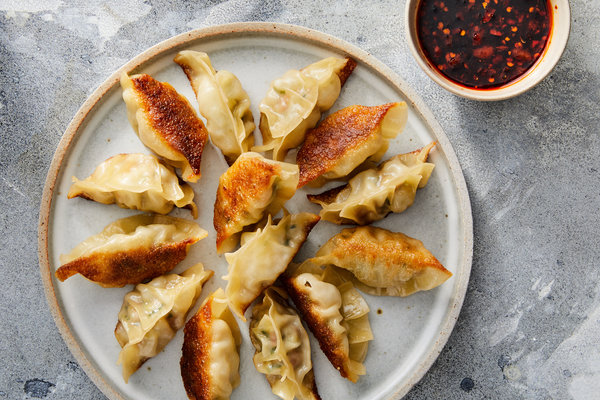
Ingredients
For the dipping sauce:
- ½ cup soy sauce
- 2 tablespoons plus 2 teaspoons rice vinegar
- Nutritional Information
Nutritional analysis per serving (6 servings)
693 calories; 51 grams fat; 7 grams saturated fat; 0 grams trans fat; 29 grams monounsaturated fat; 12 grams polyunsaturated fat; 39 grams carbohydrates; 3 grams dietary fiber; 2 grams sugars; 18 grams protein; 45 milligrams cholesterol; 1684 milligrams sodium
Note: The information shown is DiningAndCooking.com’s estimate based on available ingredients and preparation. It should not be considered a substitute for a professional nutritionist’s advice.Powered by DiningAndCooking.com
Preparation
- Prepare the gyoza dipping sauce: In a small bowl, whisk together the soy sauce and rice vinegar, plus chile oil, if using. Set aside (makes a generous 1/2 cup).
- Finely chop the cabbage or process it in a food processor into confetti-size bits, then transfer it to a sieve set over a large bowl. Toss with 2 teaspoons of the salt and let sit for 20 minutes in the sink. Gently press the cabbage to squeeze out as much water as you can.
- Combine the drained cabbage, pork, ginger, garlic, chives, soy sauce, sesame oil and the remaining 2 teaspoons salt in a large bowl and mix thoroughly just until everything is evenly distributed. (Don’t overdo it: Too much handling and the fat in the pork will begin to melt.)
- Here’s where you want to employ some extra hands to help you: Fill a small bowl with water. Sprinkle a rimmed sheet pan or two with cornstarch or potato starch to prevent the finished gyoza from sticking. For each gyoza, place a wrapper in the palm of your hand and spoon about 1 1/2 teaspoons of the filling into the center. Use the back of the spoon to smoosh it lightly (it should fill about half the wrapper). You don’t want the filling to run to the edges, but you also don’t want it sitting in a fat clump in the middle. Dip your finger into the water and run it along the perimeter of one half of the wrapper. Now fold the wet edge of the wrapper over to meet the dry edge. Crimp the edges together at one corner, then proceed around the dumpling, using your finger to push the dough into little pleats on one side and pressing them against the other side to seal it. (If you need more guidance, there are hundreds of gyoza-folding videos online.) Place the gyoza on the sheet pan as you finish them. If your gyoza seem to be sticking to one another, sprinkle each layer of gyozas with potato or cornstarch.
- To pan-fry the gyoza, you will need a lidded 10-inch nonstick pan or a well-seasoned carbon steel pan. (You could also use whatever skillet you have, but increase the oil and keep a close eye on the gyoza.) Heat 1 tablespoon neutral oil in the pan over medium heat. When hot, add 10 to 15 gyoza, flat-side down, and cook until browned on the bottoms, 2 to 3 minutes. Add enough water to come just under a quarter of the way up the gyoza (about 1/2 cup, depending on how many gyoza you have in the pan), cover, and let the water cook away until the pan is dry and the gyoza wrappers have softened completely, 3 to 4 minutes. Remove the lid, increase the heat to medium-high, and let the gyoza crisp up on the bottoms for another minute or two, depending on how crisp you like them. Serve immediately with the dipping sauce and additional chile oil. Wipe the pan clean and cook the remaining gyoza. (Alternately, uncooked gyoza can be frozen on a baking sheet in a single layer until firm and then stored in resealable plastic bags for a couple months. To cook frozen gyoza, add a second batch of water in step 4 after the first batch evaporates.)
Tip
- For a lattice net, arrange about 12 uncooked gyoza flat-side down in a tight circle in a room temperature pan. Set over medium heat and add enough water to come a quarter of the way up the gyoza (about 2/3 cup), cover, and let the water cook away until the pan is dry, about 4 to 5 minutes. Meanwhile, make the lattice batter: In a small bowl, whisk together 1 1/2 teaspoons all-purpose flour with 5 tablespoons water and 1/2 teaspoon sesame oil. Once the water has evaporated from the pan, remove the lid then add the lattice batter. Swirl the pan to distribute the batter into an even layer and cook, rotating if need be to promote even cooking, until the water has mostly evaporated and the batter has formed a crisp, golden layer at the bottom of the pan, about 3 minutes. Remove from heat. Invert a large plate on top, flip the pan over and give it a good shake to release the gyoza mixture and its lattice net. (This step takes practice, so don’t despair if it doesn’t turn out perfectly: The dumplings will still be delicious.) Repeat with the remaining gyoza and additional lattice batter, wiping out the pan and allowing it to cool a bit between each batch.

Dining and Cooking